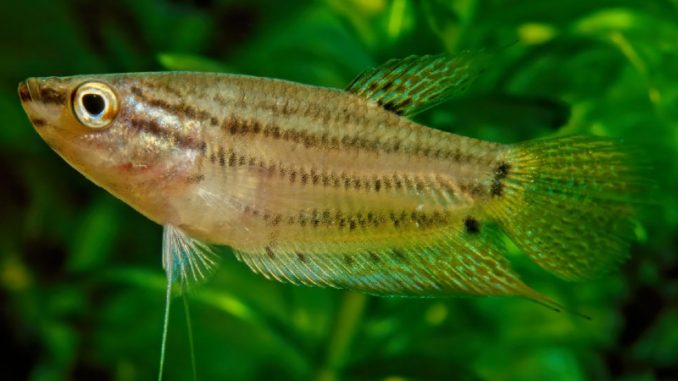
The licorice gourami is one of the many species of the Osphronemidae family of fish. This freshwater fish is popular among aquarists because of its unique appearance, interesting behaviors, and ability to survive in different conditions.
Unique among other gourami fish, its ray-finned body has a silver base with vertical black stripes and a black head with an upturned mouth.
The licorice gouramis spectacular colors, interesting behaviors, and potential for success in many conditions make it an excellent choice for aquarium hobbyists. However, male species will often display aggressive behaviors to other males of the same species.
Be cautious when mixing licorice gouramis with other species or any other fish with different coloration. If you must do it, ensure you have a larger and well-decorated tank.
TABLE OF CONTENTS
Licorice Gourami Facts & Overview
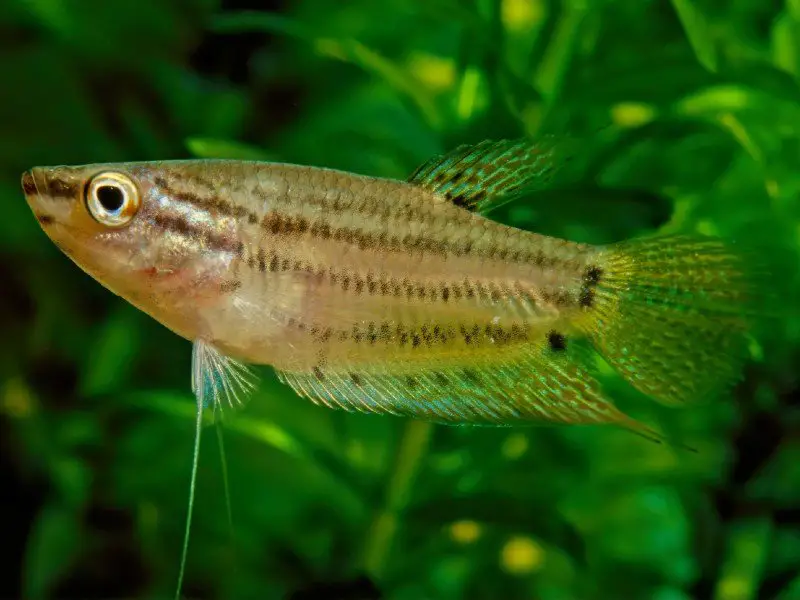
| Category | Rating |
| Care Level: | Moderate |
| Temperament: | Slightly aggressive but generally peaceful |
| Color: | Various colors, patterns, and shapes |
| Lifespan: | ~6 years |
| Size: | ~2.5 inches |
| Diet: | Omnivore |
| Family: | Osphronemidae |
| Minimum Tank Size: | 20 gallons |
| Tank Set-Up: | Freshwater, plants, caves |
| Compatibility: | Non-aggressive species |
The licorice gourami is originally from Southeast Asia, specifically the Bangka Island in Indonesia. Its scientific name is Parosphromenus deissneri and it comes from the subfamily Macropodusinae. The subfamily includes many different species, including the famous paradise fish and the Siamese fighting fish.
The licorice gourami comes from murky waters, so it has a specialized labyrinth organ that allows it to breathe air just like a goldfish. This is one of the reasons why the licorice gourami can live in imperfect water conditions. In the wild, you will find it in slow-moving black water with dense vegetation.
Blackwater fish, such as licorice gouramis, are susceptible to pH fluctuations. The optimum pH for this species is between 6.8 and 7.6.
A typical licorice gourami fish has a lifespan of 5-6 years and can grow to approximately 2.5 inches (6 cm) in length. However, if you purchase it from an aquarium store, it is more likely that the fish you bring home will be between 1 and 2 inches (2.5-5.0 cm) long.
Finding licorice gourami in a pet store or an aquarium isn’t easy because the fish isn’t popular among aquarists. However, some aquarium stores retail the fish for about $12.50. You can also find one at a local fish store if you’re lucky enough to have one near your house.
Appearance and Behaviour
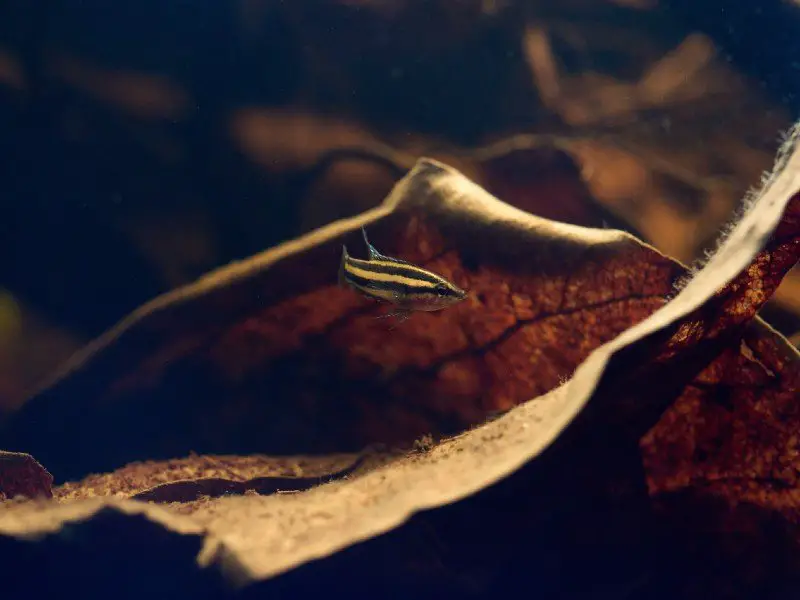
Licorice gouramis have a silver body with black vertical stripes that run from the bottom of their dorsal fin to the top of their head. The tail, belly, and back fin have blue, green, and red hues that give them a striking appearance, especially in an aquarium with a darker substrate.
The males are far bolder in color than the females. They have long, filamented dorsal, anal, and caudal fins that give them a spectacular appearance. When in breeding mode, male licorice gouramis have three black stripes on a light brown body with three white lines positioned on each side. They have dark unpaired fins with a whitish edge and a red center stripe at the middle of the fins.
The body of female black-bodied licorice gourami is light brown on the top and dark brown below. Her anal fins are blue-white near the body in most cases, but they can also be blue-white along its margin.
When stressed, licorice gouramis become nervous and prefer to stay at the bottom of the tank. You may also witness them zigzagging across the aquarium or rubbing their bodies against any hard surface. If you notice this, check your water quality immediately and do a partial water change if necessary. Sometimes, unattended water accessories such as gravel and aquatic plants affect the water quality which then alters the normal behavior of the licorice gourami.
Mature licorice gourami weighs about 0.1 kgs and grows to about 2.5 inches (6 cm) in length. There are no apparent differences in size between the sexes until it is time to breed. At this point, the female becomes plumper due to eggs, and the male becomes more colorful.
Typical Behavior
The licorice gourami appears shy. So, if you want to witness its natural behavior, provide it with a dark substrate and plenty of plants. It is often peaceful and timid, but the males can become territorial when breeding. Males are also poor community fish and prefer to be alone in a large tank.
You may also notice that licorice gouramis are territorial towards other gouramis, and the males will display some aggressive behavior towards each other. If you have a community tank with several species, the males will likely defend their territories aggressively against any bothersome gouramis, like the sparkling gourami or sunset gourami. This is especially true when they are about mate as they are territorial and competitive towards other species.
Licorice gouramis are slow swimmers and don’t like the company of frantic, quick-moving tank mates. Licorice Gouramis often swim at the top or middle of the tank to ease access to supplemental oxygen at the surface. However, they are bottom feeders and you can also find them swimming near plants and rocks.
Licorice gouramis are nocturnal, so they are active at night and rest during the day. As they get older, they tend to become more active and move more often. They also become better at hunting and will eat any food that falls on the tank floor.
Licorice Gourami Care
The licorice gourami is easy to care for, but it does require some special considerations. It is best kept in tanks that give it plenty of space to swim and low light levels so it can stay hidden when resting. It also prefers an aquarium with plenty of vegetation, like Java ferns.
The licorice gourami is a relatively delicate species. Therefore, your aquarium should replicate its natural habitat. Provide the licorice gourami with plenty of hiding spots. It is a timid fish and becomes shy and stressed very easily. As such, keep the tank well decorated with bushy plants and driftwood for the fish to dart in and out.
Make sure your aquarium has a dark substrate that imitates the murky water of its natural habitat. The licorice gourami will also appreciate the addition of floating plants, like Indian Fern or Amazon Frogbit.
Licorice gouramis enjoy live foods, like worms and brine shrimp, or frozen foods, such as bloodworm. They are also fond of algae wafers. However, they are less likely to eat dried foods or flake food, so you should feed licorice gouramis at least twice daily to ensure they get the required nutrients.
Like any other fish, the licorice gourami is also prone to some diseases. An example is Oodinum or Velvet Disease. Symptoms include sloughing of the skin accompanied by a cottony white growth on the body and fins. The best way to prevent this parasitic infection is by providing a healthy environment and keeping water conditions optimal.
Diseases
In general, licorice gouramis are quite hardy and resistant to fish diseases. However, they are likely to get illnesses when exposed to poor water conditions. An example of such is Oodinum, a parasitic protozoan disease that enters the fish through open wounds. It can also enter through skin and gills.
If you notice your fish constantly rubbing themselves against hard surfaces, they may be showing signs of the disease. With Oodinium, your fish may also have white spots on the body and fins.
Licorice gouramis can contract bacterial infections from injuries sustained after fighting with other fish. Usually, these bacteria will take hold in the internal organs rather than affecting the entire body. However, if you provide optimum water conditions, and eliminate the aggressive one likely to cause injuries, these fish are unlikely to get sick.
To reduce the risks of parasitic infections such as the Oodinium protozoan, make sure you clean your tank well. Weekly water changes are the best way to keep their habitat clean. Again, ensure that the water is within the parameters discussed above.
In case of a parasitic infection, veterinarians recommend treating the fish with praziquantel. For bacterial infections, use antibacterial drugs and improve the water conditions by fixing any abnormalities such as high or low temperatures to prevent further spreading.
Habitat and Tank Requirements
The wild licorice gourami lives in freshwater habitats with warm water temperatures. It prefers stained blackwaters, where the water has a dark color due to tannin-producing aquatic vegetation. You can find it in swampy water bodies with low visibility. However, some survive in channels and ponds with clear water.
Licorice gouramis are native to slow-moving blackwater streams of the Mekong River basin in Indochina. They are hardy in their natural environment, so they require an aquarium with the same water conditions to thrive.
The best tank set up for your licorice gourami is a warm 20-gallon aquarium (between 24 and 28 degrees Celsius), acidic to neutral pH, and densely planted with many floating plants. You need a tank that can hold at least 5 gallons of water for a pair, and a minimum 20-gallon tank is necessary for a group of these fish.
Tank Conditions
The licorice gourami prefers blackwater conditions, including a dark substrate to mirror its natural environment. To replicate this environment, you can use peat in your filter or substrate, which will turn the water dark brown or black, depending on how much you use.
Make sure that your aquarium also has some driftwood to provide hiding spots. Licorice gouramis like to find a spot and stay there for hours. They also enjoy plants on the top of the tank, as it helps them dart in and out of the vegetation when they feel threatened. Consider an efficient filtration system but with gentle water movement.
The aquarium should be about 16 by 8 inches (40 by 20 cm) and 24-28 degrees Celsius (75-82 degrees Fahrenheit). The pH level in the water should be between 6.8 and 7.2, and the water should be soft or medium-hard. Do not put salt in the tank as doing so will quickly harm your fish.
Tank Mates
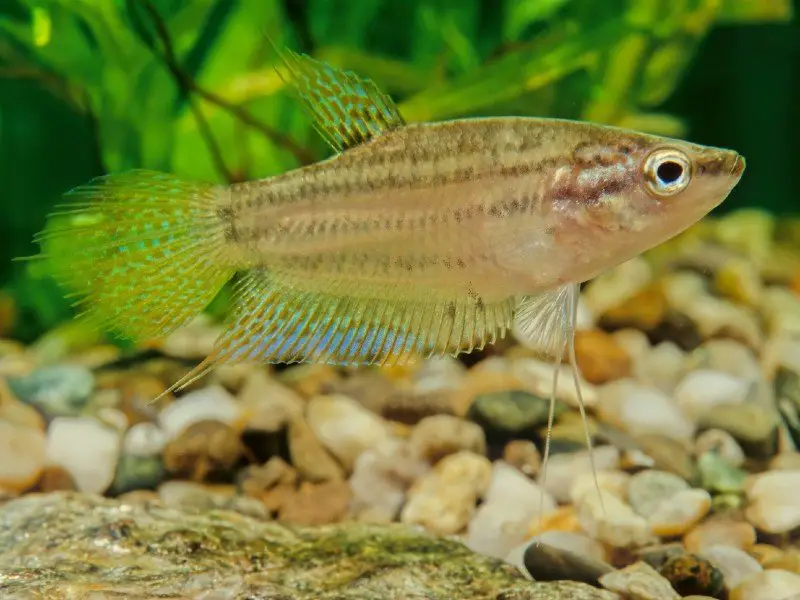
The licorice gourami is a peaceful fish but may display some aggressive behavior with fish of its kind or those that look like them. When picking tank mates for your licorice gourami, look for similarly sized and peaceful species. As with all aquarium fish, make sure the tank mates do not nip at the fins of your gourami by rehoming the offending fish to another aquarium.
Some good tank mates to consider include neon tetras, dwarf gouramis, livebearers, boraras, kuhli loaches, and sundadanio genus fish. You can also add some bottom-dwelling community fish like cory catfish to the tank. Don’t add shrimps or snails in your tank as licorice gouramis may attack and eat them.
Diet and Feeding
Licorice gouramis are omnivorous, so they can eat algae and meat. In an ideal natural habitat consisting of murky waters, you will find these fish feeding on insects, worms, and larvae, as well as plant matter.
In an aquarium environment, licorice gouramis can feed on live food such as brine shrimp and bloodworms, or algae tablets. If you want to pamper your fish with the occasional treat, try giving them live or frozen bloodworms, daphnia (water fleas), tubifex worms, and brine shrimp.
Licorice gouramis are less of a hunter just as they are swimmers, so make sure their food is within reach. Feed them once or twice a day, and vary the diet depending on whether you want to condition your fish for breeding or maintain their health.
Licorice gouramis won’t consume dried foods such as algae wafers. As a result, consider a different food type that is more appealing to this species. Take precautions not to overfeed them since doing so can pollute your tank and cause disharmony in the water quality.
Breeding
The licorice gourami is one of the easiest species of gourami to breed. Other species will require you to do extensive research into their reproductive habits before you set out to breed them.
Before you introduce your licorice gouramis to the breeding tank, cycle the tank for about four weeks. Ensure your tank has a tight-fitting lid and features a cave-like structure, preferably a coconut shell. You can also put plants or spawning mops in there. At this stage, feed the fish a varied diet of live foods and plant matter.
To induce spawning, feed your licorice gouramis live worms or tubifex. However, make sure the fish can eat them easily — if not, tear the worm into smaller pieces. If you notice your licorice gouramis acting aggressively towards each other, reduce the size of the tank and remove any aggressive individuals immediately.
Each day, raise the water temperatures by 2 degrees celsius until it reaches 28 degrees celsius. Reduce the water to 4 inches and wait for the male to build a bubble nest on the tank’s artificial cave (such as a coconut shell). Once the bubble nest is ready, introduce the ripe female to the mating tank, and she should start spawning almost immediately.
After spawning, remove the female. The male should take care of the eggs but remove the eggs after they are fertilized if he doesn’t. Ensure you feed the fish during this period. Feed them live brine shrimp initially, which should give them enough energy to fan their eggs constantly for a few days.
Should You Get a Licorice Gourami for Your Aquarium?
Licorice gouramis are some of the best-looking gouramis out there. They are also quite small and can live in tanks as small as 20 gallons. Thus, their size makes them ideal for both smaller nano tanks and ordinary community fish tanks. Before buying this fish, ensure you can provide it with the right water parameters and tank environment.
Licorice gouramis will only work well with other non-aggressive species. They are also quite shy, so make sure they have hiding places. Decorate your tank with plants that the fish can use as cover.
Aquarium hobbyists should find caring for licorice gouramis relatively straightforward. They give an appealing view of your aquarium, they are peaceful towards other fish, and they won’t cause you too much trouble. But should these cheerful little fish ever fall ill, it’s important to realize their needs.

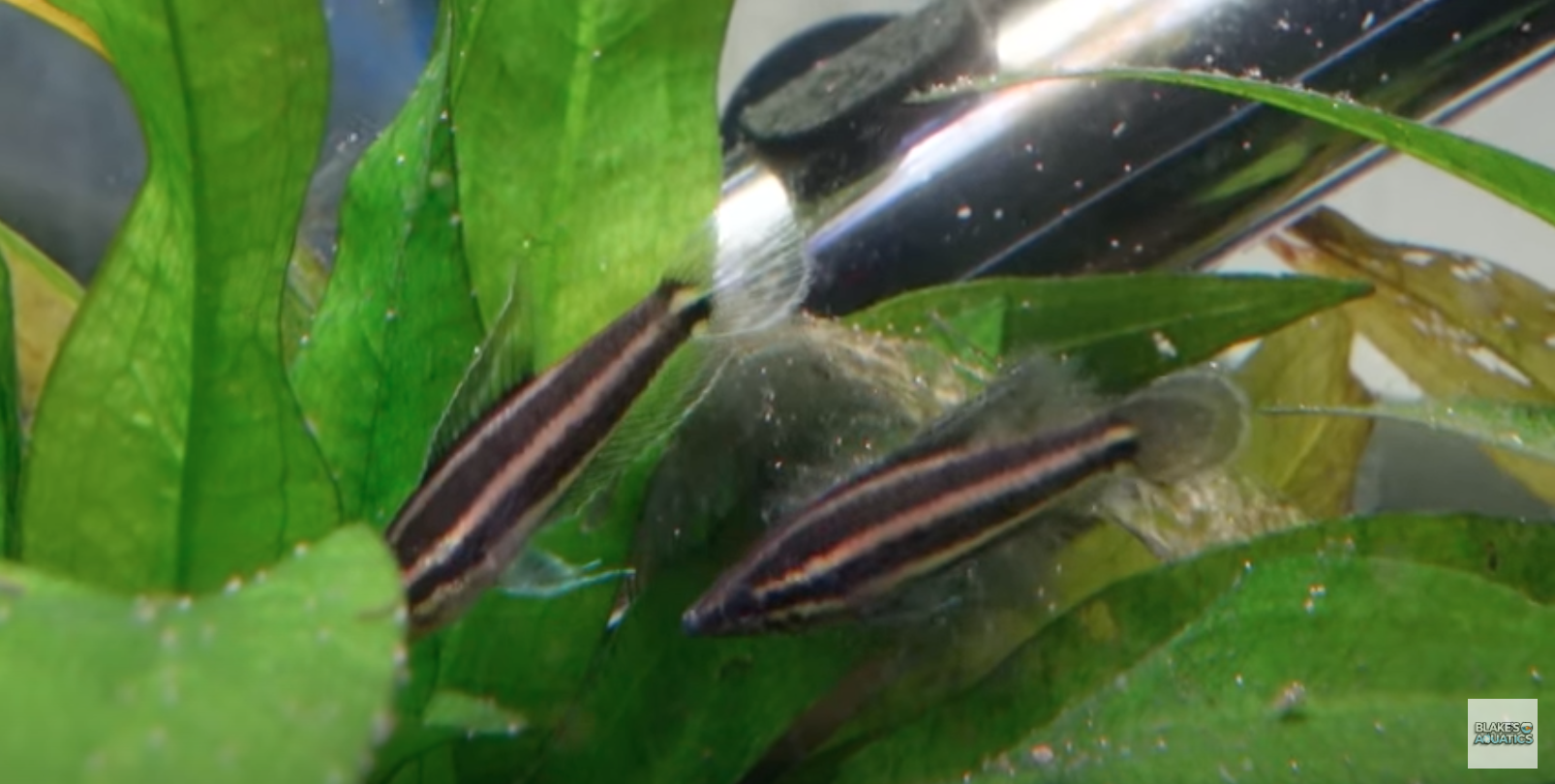
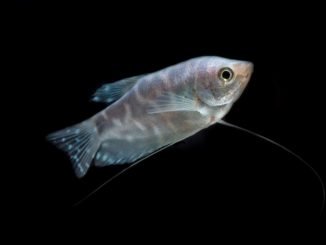
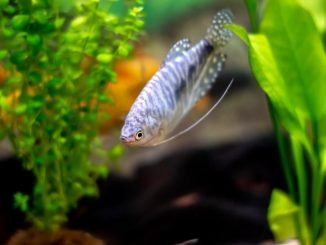
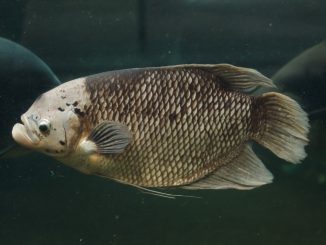
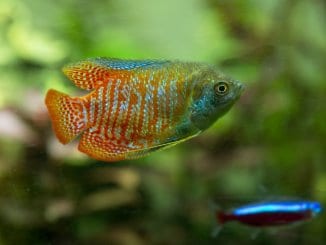
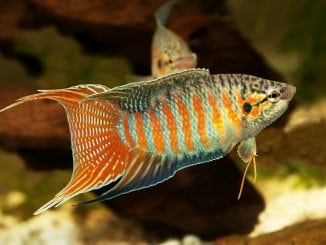
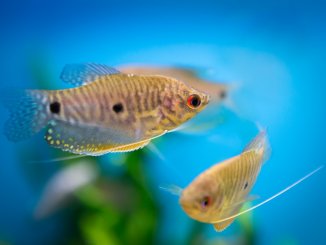
Be the first to comment